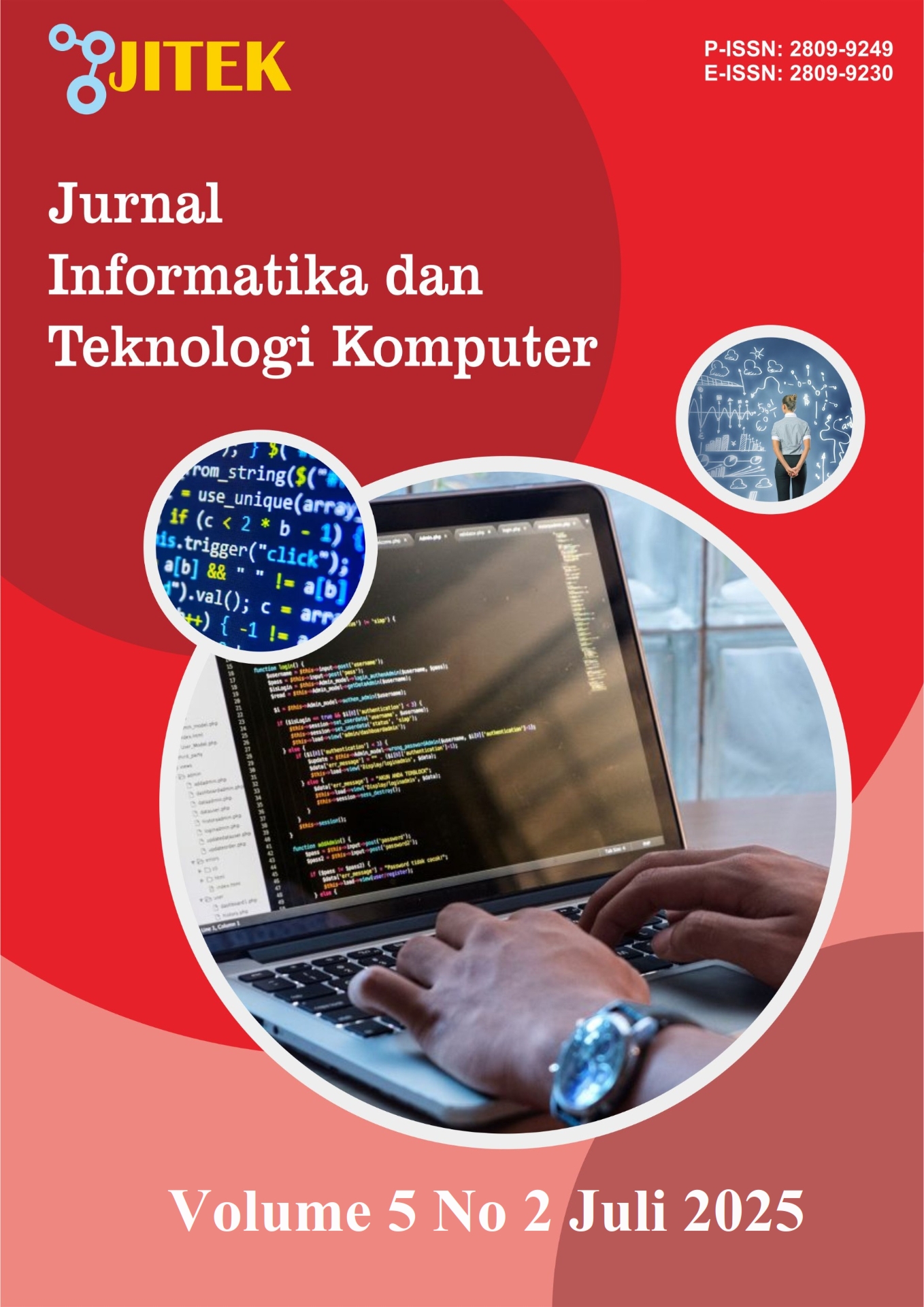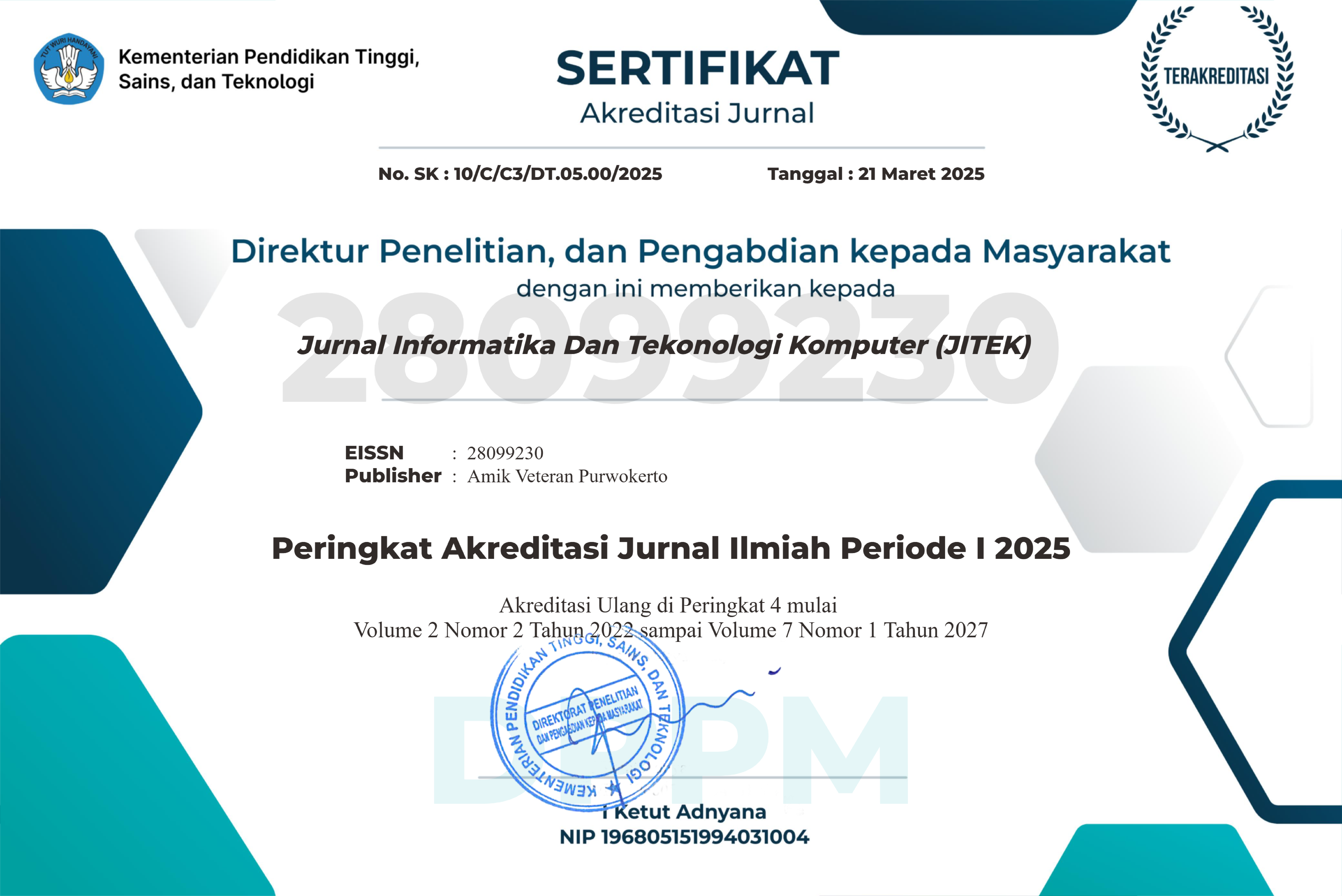Analisis Sentimen Ulasan Pengguna Aplikasi Threads di Google Play Menggunakan Algoritma XGBoost Dengan Penguatan SMOTE
DOI:
https://doi.org/10.55606/jitek.v5i2.6832Keywords:
Sentiment Analysis, SMOTE, XGBoostAbstract
Threads is a text-based social media application developed by Meta that has gained significant popularity since its launch. However, user reviews on the Google Play Store reveal an imbalanced sentiment distribution, with a dominance of positive sentiment, potentially reducing the accuracy of sentiment classification models. This study aims to evaluate the effectiveness of combining the Extreme Gradient Boosting (XGBoost) algorithm with the Synthetic Minority Over-sampling Technique (SMOTE) to address the data imbalance in user reviews of the Threads application. The dataset consists of 1,000 user reviews, which underwent preprocessing steps including case folding, cleaning, tokenization, stopword removal, and stemming. The data were then represented using the TF-IDF weighting method and analyzed using XGBoost, both before and after applying SMOTE. Results show that without SMOTE, the model achieved an accuracy of 87.60%, with a low recall for the negative class (0.69). After applying SMOTE, accuracy improved to 97.49%, and recall for the negative class reached 0.99, with balanced F1-scores for both positive and negative classes (0.98 and 0.97, respectively). These findings demonstrate that SMOTE is effective in handling class imbalance and enhancing model performance. In conclusion, the integration of XGBoost and SMOTE significantly improves fairness and accuracy in sentiment classification of app reviews, offering valuable insights for the application of machine learning in user opinion analysis. Future research is recommended to use larger datasets and consider deep learning models such as BERT.
References
[1] F. Adelia Irawan, A. Rialdy Atmadja, A. Wahana, T. Informatika, and U. Sunan Gunung Djati Bandung, “Analisis Sentimen Ulasan Aplikasi Bank Digital Menggunakan Algoritma Naive Bayes,” J. Comput. Sci. Inf. Technol. E-ISSN, vol. 4, no. 2, p. 60, 2024.
[2] Indah Tri Handayani, “19-27+Indah+Tri+Handayani,+Hafidzah,+Uppit+Yuliani,” J. Juit, vol. Vol 3, no. 1, pp. 19–27, 2024.
[3] H. Zikra et al., “THREADS USER DECLINE ANALYSIS USING THE UNFIELD THEORY OF ACCEPTANCE AND USE OF TECHNOLOGY METHOD ANALISA PENURUNAN PENGGUNA THREADS MENGGUNAKAN METODE UN-FIELD THEORY OF,” pp. 927–939, 2024.
[4] A. Ajuj, R. M. G. S. Bintang, and D. Arya Bahytsani, “Analisis Bukti Digital Forensik pada Aplikasi Threads MenggunakanMetode Digital Forensic Research Workshop,” J. Inform. Komputer, Bisnis dan Manaj., vol. 22, no. 2, pp. 1–10, 2024, doi: 10.61805/fahma.v22i2.118.
[5] S. S. Tandiapa and G. C. Rorimpandey, “Analisis Sentimen Ulasan Pengguna Pada Aplikasi Threads Dengan Metode Lexicon Based dan Naive Bayes Classifier,” J. Cahaya Mandalika, vol. 3, no. 1, pp. 339–353, 2024.
[6] Y. A. W. Windy Astuti, Rudi Kurniawan, “Analisis Data Sentimen Ulasan Aplikasi Dana di Google Play Store Menggunakan Al-goritma Naïve Bayes,” JATI (Jurnal Mhs. Tek. Inform., vol. 6, no. 1, pp. 158–163, 2024, doi: 10.36040/jati.v7i6.8178.
[7] D. Darwis, N. Siskawati, and Z. Abidin, “Penerapan Algoritma Naive Bayes Untuk Analisis Sentimen Review Data Twitter Bmkg Nasional,” J. Tekno Kompak, vol. 15, no. 1, p. 131, 2021, doi: 10.33365/jtk.v15i1.744.
[8] S. E. Herni Yulianti, Oni Soesanto, and Yuana Sukmawaty, “Penerapan Metode Extreme Gradient Boosting (XGBOOST) pada Klasifikasi Nasabah Kartu Kredit,” J. Math. Theory Appl., vol. 4, no. 1, pp. 21–26, 2022, doi: 10.31605/jomta.v4i1.1792.
[9] H. H. Sinaga and S. Agustian, “Pebandingan Metode Decision Tree dan XGBoost untuk Klasifikasi Sentimen Vaksin Covid-19 di Twitter,” J. Nas. Teknol. dan Sist. Inf., vol. 8, no. 3, pp. 107–114, 2022, doi: 10.25077/teknosi.v8i3.2022.107-114.
[10] W. M. Baihaqi, I. R. Yunita, A. S. T. Damayanti, and L. Akhaerunnisa, “Analysis of Classification Algorithm Performance on User Review Sentiment of the Muamalat DIN Application,” CogITo Smart J., vol. 9, no. 2, pp. 241–251, 2023, doi: 10.31154/cogito.v9i2.511.241-251.
[11] R. Nazar, “Implementasi Pemrograman Python Menggunakan Google Colab,” J. Inform. dan Komput. , vol. 15, no. 1, pp. 50–56, 2024.
[12] R. Gelar Guntara, “Pemanfaatan Google Colab Untuk Aplikasi Pendeteksian Masker Wajah Menggunakan Algoritma Deep Learning YOLOv7,” J. Teknol. Dan Sist. Inf. Bisnis, vol. 5, no. 1, pp. 55–60, 2023, doi: 10.47233/jteksis.v5i1.750.
[13] S. Adi et al., “ANALISIS SENTIMEN APLIKASI HALO BCA DI GOOGLE PLAY STORE MENGGUNAKAN METODE NAIVE BAYES , SUPPORT VECTOR MACHINE DAN RANDOM FOREST PENDAHULUAN,” vol. 15, no. c, pp. 69–79, 2024.
[14] I. F. Rahman, A. N. Hasanah, and N. Heryana, “Analisis Sentimen Ulasan Pengguna Aplikasi Samsat Digiital Nasional (Signal) Dengan Menggunakan Metode Naïve Bayes Classifier,” J. Inform. dan Tek. Elektro Terap., vol. 12, no. 2, pp. 963–969, 2024, doi: 10.23960/jitet.v12i2.4073.
[15] F. Matheos Sarimole and K. Kudrat, “Analisis Sentimen Terhadap Aplikasi Satu Sehat Pada Twitter Menggunakan Algoritma Naive Bayes Dan Support Vector Machine,” J. Sains dan Teknol., vol. 5, no. 3, pp. 783–790, 2024, doi: 10.55338/saintek.v5i3.2702.
[16] M. F. Y. Herjanto and C. Carudin, “Analisis Sentimen Ulasan Pengguna Aplikasi Sirekap Pada Play Store Menggunakan Algoritma Random Forest Classifer,” J. Inform. dan Tek. Elektro Terap., vol. 12, no. 2, pp. 1204–1210, 2024, doi: 10.23960/jitet.v12i2.4192.
[17] R. Q. Rohmansa, N. Pratiwi, and M. J. Palepa, “Analisis Sentimen Ulasan Pengguna Aplikasi Discord Menggunakan Metode K-Nearest Neighbor,” JIPI (Jurnal Ilm. Penelit. dan Pembelajaran Inform., vol. 9, no. 1, pp. 368–378, 2024, doi: 10.29100/jipi.v9i1.4943.
[18] N. P. Husain, S. Sukirman, and S. SAJIAH, “Analisis Sentimen Ulasan Pengguna Tiktok pada Google Play Store Berbasis TF-IDF dan Support Vector Machine,” J. Syst. Comput. Eng., vol. 5, no. 1, pp. 91–102, 2024, doi: 10.61628/jsce.v5i1.1105.
[19] H. Hidayatullah, P. Purwantoro, and Y. Umaidah, “PENERAPAN NAÏVE BAYES DENGAN OPTIMASI INFORMATION GAIN DAN SMOTE UNTUK ANALISIS SENTIMEN PENGGUNA APLIKASI CHATGPT,” JATI (Jurnal Mhs. Tek. Inform., vol. 7, no. 3, pp. 1546–1553, Oct. 2023, doi: 10.36040/jati.v7i3.6887.
[20] F. S. Pratiwi et al., “IMPLEMENTASI METODE SMOTE DAN RANDOM OVER- SAMPLING PADA ALGORITMA MACHINE LEARNING UNTUK,” vol. 8, no. 1, pp. 87–98, 2025.
[21] M. P. Pulungan, A. Purnomo, and A. Kurniasih, “Penerapan SMOTE untuk Mengatasi Imbalance Class dalam Klasifikasi Kepribadian MBTI Menggunakan Naive Bayes Classifier,” J. Teknol. Inf. dan Ilmu Komput., vol. 10, no. 7, pp. 1493–1502, 2023, doi: 10.25126/jtiik.1077989.
[22] L. N. Wakhidah, A. K. Zyen, and B. B. Wahono, “Evaluation of Telecommunication Customer Churn Classification with SMOTE Using Random Forest and XGBoost Algorithms,” vol. 9, no. 1, pp. 89–95, 2025.
[23] D. Safitri, Susanti, Rahmaddeni, and T. A. Fitri, “Perbandingan Algoritma XGBoost dan SVM Dalam Analisis Opini Publik Pem-ilihan Presiden 2024,” Indones. J. Comput. Sci., vol. 13, no. 3, pp. 4763–4775, 2024, doi: 10.33022/ijcs.v13i3.4041.
[24] “Eskiyaturrofikoh” and R. R. ’Suryono, “Analisis Sentimen Aplikasi X Pada Google Play Store Menggunakan Algoritma Naïve Bayes Dan Support Vector Machine (Svm),” JIPI(Jurnal Ilm. Penelit. dan Pembelajaran Inform., vol. 9, no. 3, pp. 1408–1419, 2024, [Online]. Available: https://www.jurnal.stkippgritulungagung.ac.id/index.php/jipi/article/view/5392
[25] M. Febiansyah et al., “Prediksi Retweet Berdasarkan Konten Dan Pengguna Dengan Metode Classifier Selection,” vol. 12, no. 1, pp. 2105–2111, 2025.
Downloads
Published
How to Cite
Issue
Section
License
Copyright (c) 2025 Jurnal Informatika Dan Tekonologi Komputer (JITEK)

This work is licensed under a Creative Commons Attribution-ShareAlike 4.0 International License.








